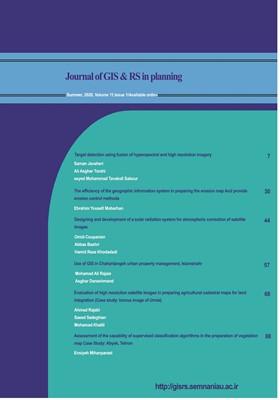Assessment of the capability of supervised classification algorithms in the preparation of vegetation map Case Study: Abyek, Tehran
Subject Areas :
1 - Department of Remote Sensing and GIS, Kharazmi University, Tehran, Iran
Keywords: Kappa coefficient, Supervised classification, Vegetation map, General accuracy, Abyek city,
Abstract :
In order to properly manage rangeland ecosystems and vegetation, it is necessary to know the relationship between their components. One of the main components of these ecosystems is vegetation and its composition, which is under the control of environmental factors. In other words, the pattern of vegetation distribution is affected by many environmental factors. Today, business awareness and its health play an important role in soil and plant management. Also, the use of vegetation maps is one of the most important pillars in the production of information for regional planning. Therefore, using remote sensing knowledge and careful study of elements, it is possible to identify vegetation and its types and its distribution using satellite images. Therefore, in the present study, two supervised classification algorithms including Maximum likehood and Spactral angel mapper have been used to evaluate the vegetation cover and its distribution for Abyek region. The overall accuracy for the MLC and SAM algorithms is 91.86 and 68.85, respectively, and the MLC and SAM kapa ratios are 0.89 and 0.62, respectively. Therefore, the MLC algorithm was recognized as a more appropriate method for assessing and estimating the vegetation distribution of the Abyek region, and therefore the MLC algorithm has a higher accuracy than the SAM algorithm. It goes without saying that the correlation between vegetation and environmental factors is one of the most important issues affecting the formation of the structure of plant communities and their distribution in each region and study area, and the specific conditions of each region are different. Recognize and manage vegetation.
_||_


